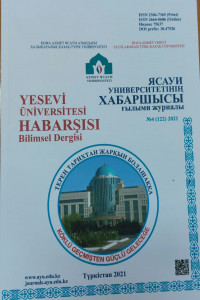Features of Representation of Color Names in Kazakh and English Toponyms
Kazakh, English, place-name, color, culture, category, ethnic group, onyms
Features of Representation of Color Names in Kazakh and English Toponyms
Kazakh, English, place-name, color, culture, category, ethnic group, onyms,
___
- 1. Meırbekov A.K., Taspolatov B.T. Etnostyń mádenı-mıfologııalyq tanymynyń negіzіn quraıtyn Qazyǵurt aımaqtyq toponımder men ańyzdardyń zamanaýı beınelerі //Iasaýı ýnıversıtetіnіń habarshysy. – 2019. – №1. – B. 219–220. [in Kazakh]
- 2. Tіleýberdıev B.M. Qazaq onomastıkasynyń lıngvokognıtıvtіk aspektіlerі. – Almaty: Arys, 2006. – 368 b. [in Kazakh]
- 3. Ábdіrahmanov Á. Qazaqstan toponımıkasynyń keıbіr máselelerі: fılol. ǵyl. kand. ... dıs. – Almaty, 1975. –120 b. [in Kazakh]
- 4. Abdrahmanov S.A. Toponımıcheskaıa polıtıka kak zerkalo vozrojdenııa gosýdarstvennostı Kazahstana // Saıasat. – 1996. – №12. – B. 22. [in Russian]
- 5. Kýıchýbaev E. Osnovnye tıpy toponımov Semırechıa: avtoref. ... kand. fılol. naýk. – Alma-Ata, 1967. – 22 b. [in Russian]
- 6. Bekenova G.Sh. Qazaqstannyń soltústіk óńіrі gıdronımderі (semantıkalyq tıpologııa): fılol. ǵyl. kand. ... avtoref. – Almaty, 2002. – 15 b. [in Kazakh]
- 7. Taspolatov B.T. Qazyǵurt óńіrі toponımııasynyń etnolıngvıstıkalyq sıpaty. – Almaty, 2010. – 17 b. [in Kazakh]
- 8. Rysbergen Q. Qazaq toponımııasynyń lıngvokognıtıvtіk jáne etnomádenı negіzderі: fılol. ǵyl. kand. ... avtoref. – Almaty, 2010. – 64 b. [in Kazakh]
- 9. Qojanuly M. Atyraý oblysynyń jer-sý attary. – Astana, 2005. – 102 b. [in Kazakh]
- 10. Mankeeva J. Qazaq tіlіnіń zattyq mádenı leksıkasy: fılol. ǵyl. kand. ... avtoref. –Almaty, 1997. – 53 b. [in Kazakh]
- 11. Vaısgerber I.L. Rodnoı ıazyk ı formırovanıe dýha. – M.: Knıjnyı dom «LIBROKOM», 2009. – 232 s. [in Russian]
- 12. Mýrzaev E.M. Toponımıka ı geografııa. – M.: Naýka, 1995. – 179 s. [in Russian]
- 13. Býdýr N.V. Povsednevnaıa jızn vıkıngov IX−XI veka. – M.: Molodaıa gvardııa, 2007. – 201 s. [in Russian]
- 14. Sýperanskaıa A.V. Imıa cherez veka ı strany. – M.: LKI, 2007. – 192 s. [in Russian]
- 15. Mýrzaev E.M. Geografıcheskaıa orıentatsııa ı ee otrajenıe v toponımıı // Izvestııa RAN. – Serııa geografıcheskaıa. – 1993. – №4. – S. 35–42. [in Russian]
- 16. Bochkareva T.V. Sıstema tsvetooboznachenıı v drevneanglııskom // Naımenovanııa tsveta v ındo-evropeıskıh ıazykah: Sıstemnyı ı ıstorıcheskıı analız / Otv. red. A.P. Vasılevıch. – M.: KomKnıga, 2007. – S. 112–125. [in Russian]
- 17. Mostepanenko E.M. Svet v prırode kak ıstochnık hýdojestvennogo tvorchestva // Hýdojestvennoe tvorchestvo. – M., 1986. – 99 s. [in Russian]
- 18. Cambridge International Dictionary of English. – London, 1995. – 63 p. [in English]
- Yayın Aralığı: Aylık
- Yayıncı: Hoca Ahmet Yesevi Uluslararası Türk-Kazak Üniversitesi
Freedom Issues in Abay's Works
G.ı. NUSSİPOVA, A.e. ABUOV, N.b. MANSUROV
G.a. RIZAKHODZHAEVA, A.yu. BALTABAYEVA
Names оf Horse Types in Kazakh
D.m. DAULETALİYEVA, B.s. TOKTAGUL, Sh.zh. ARZYMBETOVA
Using Cloud Technologies in the Educational Process
E.a. ABDYKERİMOVA, A.b. TURKMENBAYEV
Folk Ornament is One of the Means of Pedagogical Education
D.s. BOLYSBAYEV, N.а. МAKHANBETOVA, B.a. SAYNANOV, Zh.m. AGADİLOVA
Results of Archaeological Excavations in Otrar in 2020
S.t. PARMENKUL, A.a. SERALİYEV, B.s. SİZDİKOV, S. ALMAZULY
The Use of Phraseology in Political Discourse
Genre-compositional Panorama of D. Isabekov's Drama «Zhauzhurek»
Pedagogical Thoughts of M. Zhumabayev (about the Content of the Teacher's Functional Work)
